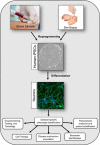Pluripotent stem cells in neuropsychiatric disorders
- PMID: 28322279
- PMCID: PMC5582162
- DOI: 10.1038/mp.2017.40
Pluripotent stem cells in neuropsychiatric disorders
Abstract
Neuropsychiatric disorders place an enormous medical burden on patients across all social and economic ranks. The current understanding of the molecular and cellular causes of neuropsychiatric disease remains limited, which leads to a lack of targeted therapies. Human-induced pluripotent stem cell (iPSC) technology offers a novel platform for modeling the genetic contribution to mental disorders and yields access to patient-specific cells for drug discovery and personalized medicine. Here, we review recent progress in using iPSC technology to model and potentially treat neuropsychiatric disorders by focusing on the most prevalent conditions in psychiatry, including depression, anxiety disorders, bipolar disorder and schizophrenia.
Conflict of interest statement
The authors declare no conflict of interest.
Figures



References
-
- Murray CJ, Barber RM, Foreman KJ, Abbasoglu Ozgoren A et al, GBD 2013 DALYs and HALE Collaborators Global, regional, and national disability-adjusted life years (DALYs) for 306 diseases and injuries and healthy life expectancy (HALE) for 188 countries, 1990–2013: quantifying the epidemiological transition. Lancet 2015; 386: 2145–2191. - PMC - PubMed
-
- Whiteford HA, Degenhardt L, Rehm J, Baxter AJ, Ferrari AJ, Erskine HE et al. Global burden of disease attributable to mental and substance use disorders: findings from the Global Burden of Disease Study 2010. Lancet 2013; 382: 1575–1586. - PubMed
-
- Vigo D, Thornicroft G, Atun R. Estimating the true global burden of mental illness. Lancet Psychiatry 2016; 3: 171–178. - PubMed
-
- Soni A. The Five Most Costly Conditions, 1996 and 2006: Estimates for the US Civilian Noninstitutionalized Population. Statistical Brief# 248. Agency for Healthcare Research and Quality: Rockville, MD, USA, 2009.
Publication types
MeSH terms
Grants and funding
LinkOut - more resources
Full Text Sources
Other Literature Sources
Medical

